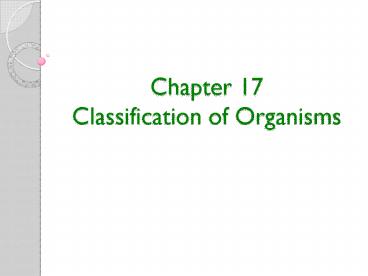Chapter 17 Classification of Organisms - PowerPoint PPT Presentation
1 / 26
Title:
Chapter 17 Classification of Organisms
Description:
Chapter 17 Classification of Organisms Section 1 - Biodiversity Biologists have named and classified almost 2 million species. They believe the total is much greater. – PowerPoint PPT presentation
Number of Views:131
Avg rating:3.0/5.0
Title: Chapter 17 Classification of Organisms
1
Chapter 17Classification of Organisms
2
Section 1 - Biodiversity
- Biologists have named and classified almost 2
million species. They believe the total is much
greater. - Various methods of classification have been used
to organize their knowledge of the tremendous
number of species. Species have been placed in
categories based on particular characteristics.
3
Section 1 - Biodiversity
- Classifying Organisms
- Naturalists have invented several systems for
categorizing biodiversity, which is the variety
of organisms considered at all levels from
populations to ecosystems.
4
Section 1 - Biodiversity
- Taxonomy
- Naturalists replaced Aristotles classification
system because it did not adequately cover all
organisms and because his use of common names was
problematic. - Taxonomy is the science of describing, naming,
and classifying organisms.
5
Section 1 - Biodiversity
- Taxonomy (cont.)
- The Linnaean System
- Carolus Linnaeus devised a seven-level
hierarchical system for classifying organisms
according to their form and structure. - From the most general to the most specific,the
levels are kingdom, phylum, class, order,
family,genus, and species.
6
Section 1 - Biodiversity
- Classification Hierarchy of
- Organisms
7
Section 1 - Biodiversity
- Linnaeus's Levels of Classification
8
Section 1 - Biodiversity
- Levels of Classification
- Binomial Nomenclature
- An important part of Linnaeuss system was
assigning each species a two-part scientific
namea genus name, such as Homo, and a species
identifier, such as sapiens. - This system of a two-part name is known as
binomial nomenclature.
9
Section 2 - Systematics
- Systematics is the goal to classify organisms in
terms of their natural relationships.
10
Section 2 - Systematics
- Phylogenetics
- A modern approach to taxonomy is systematics,
which analyzes the diversity of organisms in the
context of their natural relationships. - When classifying organisms, scientists consider
fossils, homologous features, embryos,
chromosomes, and the sequences of proteins and
DNA.
11
Section 2 - Systematics
- Phylogenetics (cont.)
- A phylogenetic diagram displays how closely
related a subset of taxa are thought to be.
12
Section 2 - Systematics
- Phylogeny
13
Section 2 - Systematics
- Phylogenetics (cont.)
- Evidence of Shared Ancestry
- Homologous features as well as similarities in
patterns of embryological development provide
information about common ancestry.
14
Section 2 - Systematics
- Cladistics
- Cladistics uses shared, derived characters as the
only criterion for grouping taxa.
15
Section 2 - Systematics
- Cladogram Major Groups of Plants
16
Section 2 - Systematics
- Cladistics (cont.)
- Molecular Cladistics
- Molecular similarities (such as similar amino
acid or nucleotide sequences), as well as
chromosome comparisons, can help determine common
ancestry. - Chromosomes
- Analyzing karyotypes can provide more information
on evolutionary relationships.
17
Section 2 - Systematics
- Similarities in Amino Acid Sequences
18
Section 2 - Systematics
- Cladistics
19
Section 2 - Systematics
- Phylogenetic Diagram of Mammals
20
Section 3 Modern Classification
- Biologists continue to develop taxonomies to
organize lifes enormous diversity. Revisions are
made to reflect current hypotheses of the
evolutionary relationships between groups
21
Section 3 Modern Classification
- The Tree of Life
- Revising the Tree
- The phylogenetic analysis of rRNA nucleotide
sequences by Carol Woese led to a new tree of
life consisting of three domains aligned with
six kingdoms.
22
Section 3 Modern Classification
- Three Domains of Life
- The three domains are Bacteria, Archaea, and
Eukarya. - Domain Bacteria
- Domain Bacteria aligns with Kingdom Eubacteria,
which consists of single-celled prokaryotes that
are true bacteria.
23
Section 3 Modern Classification
- Three Domains of Life (cont.)
- Domain Archaea
- Domain Archaea aligns with Kingdom
Archaebacteria, which consists of single-celled
prokaryotes that have distinctive cell membranes
and cell walls. - Domain Eukarya
- Domain Eukarya includes the kingdoms Protista,
Fungi, Plantae, and Animalia. - All members of this domain have eukaryotic cells.
24
Section 3 Modern Classification
- Phylogenetic Diagram of Major Groups of Organisms
25
Section 3 Modern Classification
- Six Kingdoms
26
Section 3 Modern Classification
- Kingdom and Domain Characteristics































